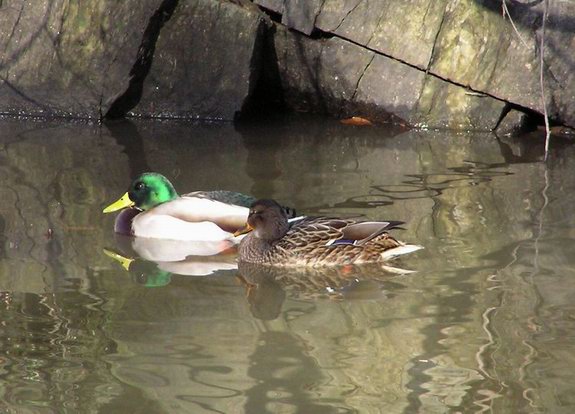|
Return to Hiker's Notebook Home Page
Common Name: Mallard - From the Old French mallart from the Latin mallardus that is a combination form derived from the word male. The etymology is not well defined; it is likely that the distinctive plumage of the male duck is the basis for distinguishing the species with a name derived from "male of the wild duck."
Scientific Name: Anas platyrhynchos - The generic name is the Latin word for duck which is ascribed to the Sanskrit ati meaning aquatic bird. The species name is from the Greek platy meaning flat and rhynchos meaning snout, bill or beak. Taken together the scientific name literally means flat-billed duck.
The sexual dimorphism of the mallard is among the most pronounced of all the vertebrates, affording a clear and unmistakable identification. The male drake's iridescent dark green head, white neck ring, chestnut brown breast, brownish gray back and white flanks stand in stark contrast to the female's maculation of buff, ecru and dark brown. The female mallard is referred to as a hen or more properly duck; the term mallard duck is speciously applied to the species absent the knowledge that mallard is its singular name. The brilliant plumage of the drake is actually an alternate breeding plumage; the normal plumage is called basic, or eclipse; the iridescence is transmuted to dark green and the body takes on a more camouflaged mottled coloration like that of the duck. In France, the mallard is known as the canard colvert, roughly translated as duck with the green feathers on the side of the head. In Spain, A. platyrhynchos is pato de collar, or duck with the collar, to emphasize the distinctive white neck ring.
The mallard drake is sexually aggressive. This may syllogistically (cause and effect) explain both the success of the species among the duck genera and also the social behavior of the mallards - the success of aggressive males in procreating transmits the aggression genes to succeeding generations. The mallard is nominally monogamous, a singular male-female relationship being established sometime in the fall; however, courtship type behavior can be observed throughout the winter, and paired males not infrequently pursue other females. During the spring mating season, there are several observed behaviors in a addition to monogamous mating that are suggestive of drake sexuality. Several males will chase after a single female to ultimately sequentially copulate; this is euphemistically called "rape flight." Rape is considered to be a normal reproductive strategy among mallards. It is estimated that about ten percent of mallard drakes form same sex relationships, the homosexuality providing an outlet for their aggressive sexuality.
The mallard duck is deserted by the drake shortly after mating and builds a nest on the ground near water to lay about 10 eggs, her plumage affording camouflage. The ducklings hatch after about a month and are precocial, they can swim and feed themselves immediately. The nest is abandoned following parturition and the ducklings are cared for by the female, summoning the group with the characteristic quack known as the "decrescendo call," a musical term for sound with gradually diminishing loudness.
The ubiquitous mallard is the progenitor of almost all domestic duck breeds and is native to North America and Eurasia. The Muscovy duck, a native of South America, is considered the only other genetic source for domestic ducks. It is estimated that the 23 million individual mallards that make up the global population range over about 10 million square kilometers (one tenth) of the earth's land surface. The National Audobon society estimates that there are 13 million mallards in North America. The more northerly birds are generally larger than those in the south, an example of Bergmann's Rule and they have smaller appendages, following Allen's Rule; both adaptations the result of an evolutionary trend that favors adaptations that minimize heat loss in colder climates.
The evolution of the mallard is fairly recent, the genus Anas is thought to have originated sometime in the late Pliocene or early Pleistocene epoch, about two million years ago, probably in Siberia. Because of the recent and rapid expansion of the mallard, its phylogeny, or evolutionary relationship, is confusing. The various species of the genus are very closely related - for example the mallard and the American black duck (A. rubripes) differ in their mitochondrial DNA by only 0.8 percent. The net result is that the mallard can interbreed with some 45 other species of ducks. "Mallardization" of the global duck populations is a problem whose extent parallels the general spread of non-native species to new areas worldwide. Mallard-based domestic ducks that are introduced by aesthetically minded but misdirected humans to populate their local pond become feral; the resultant mallard hybrids are physically larger with a diverse gene pool. Introduced mallards interbreed with native duck populations to the extent that hybridization threatens to extirpate the species; it is estimated that 95 percent of New Zealand's native gray ducks have been hybridized and that the Hawaiian duck has become completely hybridized on the island of Oahu. |
